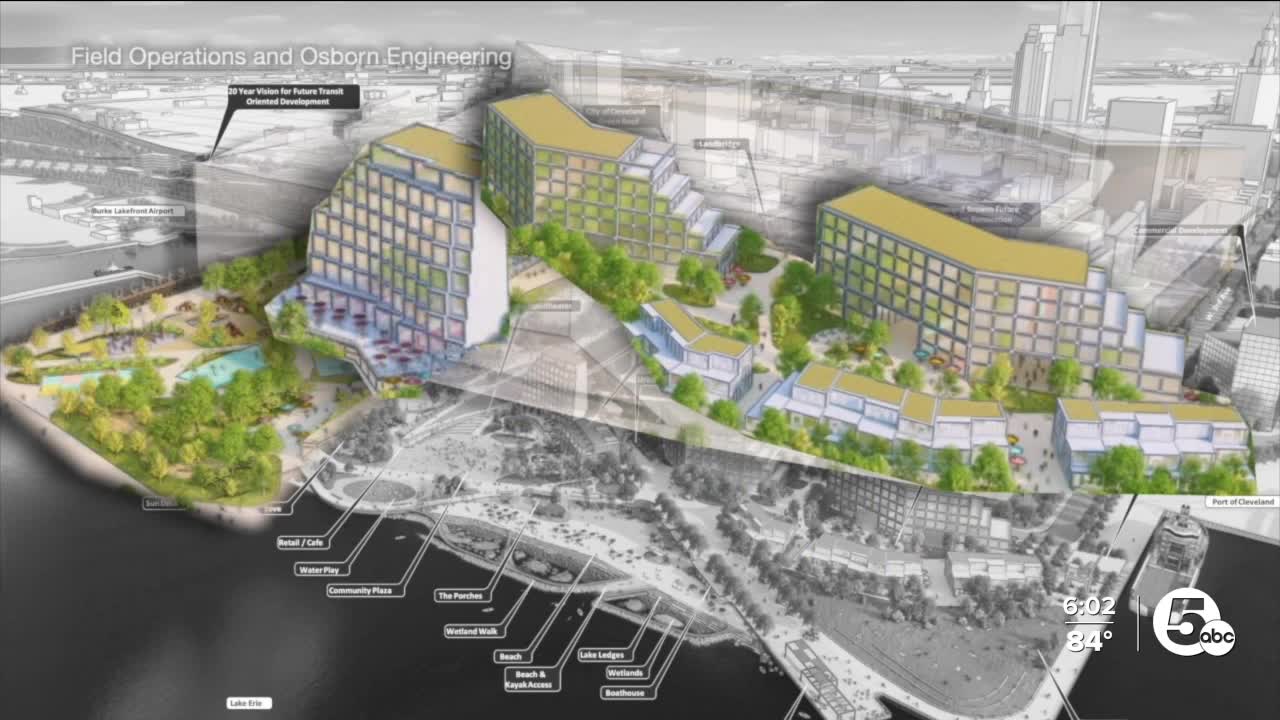CLEVELAND — Cleveland is seeking developers for 50 acres of its Downtown lakefront – including the land where Huntington Bank Field now stands.
During an interview, Mayor Justin Bibb said he’s being “pragmatic and crystal-eyed” about the Cleveland Browns’ plans to leave the lakefront for a new stadium in Brook Park in 2029. At this point, he said, it makes sense to pitch developers on the entire site, including the stadium, and not just the 25 or so acres of parking lots to the north and east.

“We have certainty that the Browns are going to Brook Park,” Bibb said. “And now we have 50 acres of prime real estate on our city’s lakefront to develop. And so we’re excited to get proposals from developers from across, really, the world, who have been reaching out.”
On Tuesday, the city and the nonprofit North Coast Waterfront Development Corp. sent out a 50-page solicitation – called a request for qualifications – through the CBRE real estate brokerage. Responses from developers are due in September.
Read it below:
The Bibb administration and the North Coast nonprofit aim to pick a developer – or developers – by the end of this year. It’s too early to say when construction will start.
It’s not clear how much developers will be willing to do while the stadium is standing – or being torn down. “Obviously, that acreage will be paused until the Browns are no longer playing football,” Bibb said, while standing on a parking lot near the northeast corner of the property. “But we have some acreage right here that we can start working on.”
Site preparations, like adding utilities, installing streets and regrading and repaving land, could coexist with a stadium or a demolition zone. Vertical construction is trickier.
“When you’re talking about a 50-acre development site, that’s a really complicated, difficult site,” said Scott Skinner, executive director of the North Coast nonprofit.
He’s acknowledged that losing the Browns is likely to slow the pace of development, delaying projects like hotels, apartments and restaurants until 2031 or later.
RELATED: Waterfront leader says a Browns stadium move will slow Cleveland's lakefront development
It could take decades to fill the entire 50-acre footprint, where the city and the North Coast nonprofit will need to work with developers to find a new anchor – a destination that, like the stadium now, can draw crowds and serve as a centerpiece for the district.
“We want to bring in partners who share our vision now, so we can start the work,” Skinner said. “So if the stadium is demolished in early 2029, we are ready to go.”
It’s also unclear who would pay to tear down the stadium, which the city owns.

Bibb said he hopes Browns owners Jimmy and Dee Haslam “will be good corporate citizens and ensure that there is a very quick and fast demolition of that stadium.”
And if the Browns pivot and take another look at renovating on the lakefront?
“We would welcome them back with open arms,” Skinner said.
‘The financing, the plan and the political will’
Cleveland has solicited development proposals for parts of the Downtown lakefront before. In 2013, under former Mayor Frank Jackson, the city offered up 28 acres, stretching from North Coast Harbor west to the parking lots north of the stadium.
Developers pitched everything from film studios and a school to hotels, restaurants, offices and high-end apartments. In 2014, the Jackson administration chose a joint venture between local developer Dick Pace and the Trammell Crow Co., a major Dallas-based real estate company, to lease and remake the city-owned properties.
Pace put up two buildings – a restaurant and a low-rise apartment building along the East Ninth Street Pier near the Rock & Roll Hall of Fame. But the rest of the project, a vision for lots more housing, offices, retail, parking and, possibly, a school, never materialized.
Trammell Crow and Pace’s Cumberland Development parted ways in 2019. The city and Pace cut ties in 2020. At that time, the Browns were ramping up their efforts to reshape the future of the waterfront, where the team was considering a big stadium renovation.
In 2021, Haslam Sports Group released plans for a broad land bridge that would link the lakefront to the heart of Downtown. Preliminary drawings included apartments, offices, retail, hotels and green space north of the stadium. The proposal also called for converting a stretch of the Shoreway into a slower, pedestrian-friendly boulevard.
If that sounds familiar, it’s because Cleveland is getting ready to build a land bridge and reimagine the Shoreway, with help from $150 million in federal and state grants.
Watch what Bibb had to say about the land bridge:
RELATED: Cleveland wins $69 million federal grant for lakefront land bridge and Shoreway makeover
The first phase of construction is scheduled to start in 2027.
“We’ve been talking about (the) lakefront for nearly 100 years,” Bibb said. “And we finally have the financing, the plan and the political will to get the job done.”
Skinner echoed that, saying there are a few things that make this attempt to reach the water different. The bridge and the road changes are key to opening up the site, giving developers more confidence that people will come down to whatever gets built.
The city also has come up with new ways to pay for lakefront infrastructure, public space and programming. A quasi-governmental entity called a new community authority can work with lakefront property owners and institutions to add modest fees onto parking, restaurant bills and other spending in the area, to support new investments.
RELATED: Cleveland takes more steps toward lakefront plan
A new tax-increment financing district blanketing Downtown is designed to capture some property-tax revenues from growth and use them to pay for streets, parks, sidewalks and other basic building blocks of a new neighborhood.
RELATED: Cleveland approves new financing district to spur future waterfront projects
“Those are all game-changers in terms of how we fund infrastructure, how we pay for public space and public amenities,” said Skinner, who has a background in real estate and is dedicated, full-time, to clearing a path for lakefront development.
Perhaps most importantly, he said, public-sector and business leaders agree on the need to do something with all that barren land. That regional alignment persists, in spite of deep fractures in the civic landscape over the Browns’ moving plans.
‘The scale of our ambitions’
The city is seeking developers who want to tackle the entire 50-acre project – or just one piece of it. Skinner said CBRE is sending the marketing materials to more than 17,000 local, regional and national developers.
“We know of a number of groups who intend to respond to this,” he said. “And we are expecting a large number of responses from groups that we don’t even know of yet.”
The solicitation builds on a master plan that the city spent years crafting, based on public feedback and collaborations with landscape architects and engineers.
That plan centers on public spaces, from a playground and a splash pad to places for fishing and watching the sunset. It also includes a hotel, apartments and a food hall.
RELATED: First look — Cleveland’s final lakefront master plan
But there’s a huge hole in that plan – where a renovated stadium was supposed to go. Bibb says the master plan is nonetheless still “very real,” with the guiding concepts of public access and year-round activities that everyday Clevelanders can enjoy.
“The North Coast Yard is a prime example of the kind of development we want to see,” the mayor said, referring to a pop-up park the North Coast nonprofit opened in June.
Made of shipping containers and fabric-covered Quonset huts, the seasonal venue sits alongside the Steamship William G. Mather Museum, north of the Great Lakes Science Center. There’s something happening most days of the week, from soccer and basketball to water activities for kids, roller-skating and live music – with a bar and food trucks.
“A great mix of public space,” Bibb said. “A great mix of food and hospitality.”
RELATED: NY or CLE? North Coast Yard offers unique basketball venue on Lake Erie shores
He and his family were there on the Fourth of July for a free fireworks celebration. At one point, he talked to a family that drove Downtown from Medina to watch the show.
“I want something that brings people together,” the mayor said. “That speaks to the scale of our ambitions as a city.”
Cleveland can’t sell lakefront land without a public vote. Instead, the city is offering long-term land leases, with the prospect of lower rent for developers during construction – or for projects that provide outsized public access or major economic growth potential.
Developers also could qualify for property-tax breaks, tax credits tied to job creation and, long-term, a first shot at building on additional city-owned land in the area.
The lakefront district includes the sprawling Muni Lot south of the Shoreway. It also includes city-owned Burke Lakefront Airport, which Bibb has talked about closing – a move that would require an act of Congress, if it’s going to happen anytime soon.
RELATED: Cleveland makes case for airport shutdown
“On Burke, we continue to talk to our delegation in Washington, D.C., in terms of how to support us,” Bibb said. “Obviously, there’s a new administration in the White House. We have two new U.S. Senators representing Cleveland … so we need their support, as well as alignment with our federal delegation to work with us to help us close Burke.
“But immediately, the near-term priority is activating and developing this 50 acres first, to make sure we can keep this momentum alive.”
He said the lakefront is part of a much bigger picture, along with a major overhaul of Cleveland Hopkins International Airport; a huge riverfront redevelopment plan being led by the real estate arm of billionaire Dan Gilbert’s family of companies; strategies for building more homes and cleaning up blighted industrial sites; and ongoing attempts to cut through bureaucracy at City Hall, to make it easier for people to interact with government.
“This is the Cleveland era,” he said. “Where we’re showing the city and the region and the nation economic resurgence in action.”






